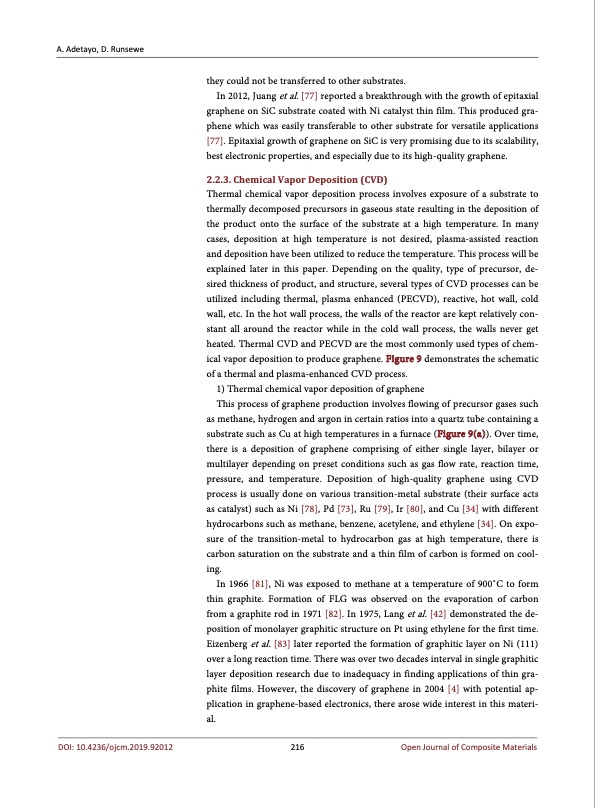PDF Publication Title:
Text from PDF Page: 010
A. Adetayo, D. Runsewe they could not be transferred to other substrates. In 2012, Juang et al. [77] reported a breakthrough with the growth of epitaxial graphene on SiC substrate coated with Ni catalyst thin film. This produced gra- phene which was easily transferable to other substrate for versatile applications [77]. Epitaxial growth of graphene on SiC is very promising due to its scalability, best electronic properties, and especially due to its high-quality graphene. 2.2.3. Chemical Vapor Deposition (CVD) Thermal chemical vapor deposition process involves exposure of a substrate to thermally decomposed precursors in gaseous state resulting in the deposition of the product onto the surface of the substrate at a high temperature. In many cases, deposition at high temperature is not desired, plasma-assisted reaction and deposition have been utilized to reduce the temperature. This process will be explained later in this paper. Depending on the quality, type of precursor, de- sired thickness of product, and structure, several types of CVD processes can be utilized including thermal, plasma enhanced (PECVD), reactive, hot wall, cold wall, etc. In the hot wall process, the walls of the reactor are kept relatively con- stant all around the reactor while in the cold wall process, the walls never get heated. Thermal CVD and PECVD are the most commonly used types of chem- ical vapor deposition to produce graphene. Figure 9 demonstrates the schematic of a thermal and plasma-enhanced CVD process. 1) Thermal chemical vapor deposition of graphene This process of graphene production involves flowing of precursor gases such as methane, hydrogen and argon in certain ratios into a quartz tube containing a substrate such as Cu at high temperatures in a furnace (Figure 9(a)). Over time, there is a deposition of graphene comprising of either single layer, bilayer or multilayer depending on preset conditions such as gas flow rate, reaction time, pressure, and temperature. Deposition of high-quality graphene using CVD process is usually done on various transition-metal substrate (their surface acts as catalyst) such as Ni [78], Pd [73], Ru [79], Ir [80], and Cu [34] with different hydrocarbons such as methane, benzene, acetylene, and ethylene [34]. On expo- sure of the transition-metal to hydrocarbon gas at high temperature, there is carbon saturation on the substrate and a thin film of carbon is formed on cool- ing. In 1966 [81], Ni was exposed to methane at a temperature of 900 ̊C to form thin graphite. Formation of FLG was observed on the evaporation of carbon from a graphite rod in 1971 [82]. In 1975, Lang et al. [42] demonstrated the de- position of monolayer graphitic structure on Pt using ethylene for the first time. Eizenberg et al. [83] later reported the formation of graphitic layer on Ni (111) over a long reaction time. There was over two decades interval in single graphitic layer deposition research due to inadequacy in finding applications of thin gra- phite films. However, the discovery of graphene in 2004 [4] with potential ap- plication in graphene-based electronics, there arose wide interest in this materi- al. DOI: 10.4236/ojcm.2019.92012 216 Open Journal of Composite MaterialsPDF Image | Synthesis and Fabrication of Graphene and Graphene Oxide

PDF Search Title:
Synthesis and Fabrication of Graphene and Graphene OxideOriginal File Name Searched:
OJCM-2019042814574897.pdfDIY PDF Search: Google It | Yahoo | Bing
Salgenx Redox Flow Battery Technology: Power up your energy storage game with Salgenx Salt Water Battery. With its advanced technology, the flow battery provides reliable, scalable, and sustainable energy storage for utility-scale projects. Upgrade to a Salgenx flow battery today and take control of your energy future.
CONTACT TEL: 608-238-6001 Email: greg@infinityturbine.com (Standard Web Page)